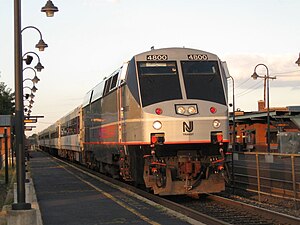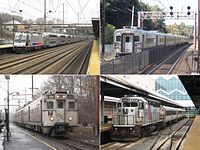Raritan Valley Line
| Lua error: expandTemplate: template "NJT color" does not exist. | |||
|---|---|---|---|
 | |||
 Train #5439, a p.m. peak train on the Raritan Valley Line, about to stop at the Dunellen station, located in Dunellen, New Jersey (2008). | |||
| Overview | |||
| Status | Operational | ||
| Owner | Amtrak (east of Hunter) CSAO (Hunter to Aldene) New Jersey Transit (Aldene westward) | ||
| Locale | Northern New Jersey | ||
| Termini |
| ||
| Stations | 20 | ||
| Service | |||
| Type | Commuter rail | ||
| System | New Jersey Transit | ||
| Operator(s) | New Jersey Transit | ||
| Rolling stock | F40PH-2CAT locomotives GP40FH-2 locomotives Alstom PL42AC Bombardier ALP-45DP locomotives Comet IIM, IV, and V Bombardier MultiLevels | ||
| Daily ridership | 21,650 (average weekday)[1] | ||
| Technical | |||
| Track gauge | 1,435 mm (4 ft 8+1⁄2 in) | ||
| Electrification | 25 kV 60 Hz AC (Newark-New York only) | ||
| Operating speed | 80 mph (128.75 km/h) (top speed) | ||
| |||
The Raritan Valley Line is a commuter rail service operated by New Jersey Transit (NJT) which serves passengers in municipalities in Union, Somerset, and Hunterdon counties in New Jersey.
The station's most frequent western terminus is Raritan station in Raritan. Some weekday trains continue further west and terminate at the High Bridge station, located in High Bridge.
Until March 2014, the RVL's eastern terminus was Pennsylvania Station in Newark, with morning rush hour service to Hoboken Terminal. In order to continue to Pennsylvania Station in New York City, RVL passengers were required to transfer to a Northeast Corridor Line or North Jersey Coast Line train at Newark Penn. Beginning in 2014, some Raritan Valley Line trains began serving New York Penn Station via Secaucus Junction, which enabled riders on the Main Line, Bergen County Line, and Pascack Valley Line to access the line.
The Raritan Valley Line is colored orange on New Jersey Transit's system map. Its symbol is the Statue of Liberty, a homage to the Central Railroad of New Jersey whose logo was also the Statue of Liberty.[2]
Description
Most of the line follows the main line of the former Central Railroad of New Jersey. Historically, CNJ trains ran on this line, as part of its Lehigh-Susquehanna Division, from Scranton, Wilkes-Barre, Allentown, Bethlehem and Easton in eastern Pennsylvania, through Elizabeth and Bayonne to Jersey City.
Until 1967 CNJ service terminated at the company's Communipaw Terminal in what is today Liberty State Park.[3] This station, which was also served by Reading Company trains to Philadelphia and B & O service to Washington, D.C. and beyond, had connections by chartered bus or ferry into Manhattan (the ferries serving the financial district).
At the end of April 1967, the Aldene Connection opened, connecting the CNJ main line to the Lehigh Valley Railroad (now Conrail's Lehigh Line), and trains were re-routed to Newark Penn Station on the Northeast Corridor via Hunter Connection. This allowed CNJ to end the ferry service between Jersey City and Manhattan, which was losing money.[4]
Trains initially could not go beyond Newark Penn Station to New York Penn Station because the locomotives were diesel-powered, and diesel locomotives cannot operate in the North River Tunnels. The introduction of ALP-45DP dual-mode locomotives allows for direct service to New York Penn Station.[5] Limited, service to New York Penn Station started as a pilot program on March 3, 2014. Select trains scheduled to arrive at New York Penn Station provide one-seat rides to New York. This original "pilot project" schedule has been subsequently expanded to include additional trains.
Unlike the Northeast Corridor, the majority of station stops on the Raritan Valley Line are not wheelchair accessible. Newark Penn Station, Union, Cranford, Westfield, Plainfield, and Somerville are accessible, high-platform stations. Roselle Park has a high platform but does not have a ramp or elevator to the street.[6]
Rolling stock

The Raritan Valley Line uses all diesel service, with locomotives consisting of the F40PH-2CAT, GP40PH-2(A and B) GP40FH-2, Alstom PL42AC, and GE P40DC locomotives. It originally used a 5- or 6-car set of Comet series coaches, and since late 2008, Bombardier Multilevel Series Coaches were added and replaced the Comet coaches. Most trains now consist of an PL42AC or ALP-45DP and a six-car set of Multilevels.
With the initiation of select, direct, service to New York Penn Station on the Raritan Valley Line in March 2014, dual-mode Bombardier ALP-45DP locomotives (combination diesel and electric power) were added to the RVL rolling stock to incorporate the "one seat ride" to and from Raritan or High Bridge and Penn Station in New York. The dual powered locomotives will remain on the RVL indefinitely.
The line's rolling stock is stored at the Raritan Yard, the line's only rail yard, located just west of the station. All eastbound trains change crews here and trains are normally stored here overnight. This is also one of two fueling facilities for NJT locomotives (the other is at Hoboken Terminal). All trains terminating in Newark head to the Meadows Maintenance Complex in Kearny, New Jersey to be stored.
Proposed extensions
Phillipsburg
Service beyond High Bridge to Phillipsburg Union Station in Phillipsburg was discontinued in December 1983 ostensibly due to low ridership coupled with infrequent service west of High Bridge.[citation needed] Then, in November 1989, the New Jersey Department of Transportation (NJ DOT) severed the rail line between Alpha and Phillipsburg during construction of I-78. This was done in order to avoid having to build an overpass over the out-of-service trackage.[7] Trackage was later dismantled between Phillipsburg and Bloomsbury, where the line connects with Norfolk Southern's parallel Lehigh Line. New Jersey Transit could build the stations along the existing Norfolk Southern Lehigh Line towards Allentown or on the existing Norfolk Southern Reading Line towards Reading.
Since 1984, there have been repeated calls for resumption of service to Phillipsburg to relieve traffic congestion on the parallel I-78 and U.S. Route 22. The Raritan Valley Rail Coalition, formed in 1998 by former U.S. Congressman Bob Franks, is currently looking for cost-effective ways to improve mobility, reduce highway congestion, and increase transit ridership along the Raritan Valley Line. Their study is slated for completion in January 2010.[8] In addition, real estate developers have touted former industrial hub Phillipsburg as an excellent candidate for restored commuter rail service, saying "P'burg. . .a good candidate for rail service..."[9]
NJ Transit has been responsive to the idea, and initiated an environmental impact statement. It was determined that service restoration will take approximately four years and cost $90 million.[citation needed]
In 2010 Easton Mayor Sal Panto Jr. promoted the restoration of rail service to Easton or Phillipsburg and possibly Allentown or Bethlehem.[10]
West Trenton
Another plan that has been proposed is to restore service on the former Reading Railroad's Jersey City branch track between Ewing and Bound Brook to be called the West Trenton Line, providing a direct link to the SEPTA service of the same name and establishing an additional link to Philadelphia. To date, no funding for the proposal has been secured.[11]
Stations
References
- ^ NJ TRANSIT QUARTERLY RIDERSHIP TRENDS ANALYSIS November 2012 Retrieved May 23, 2014.
- ^ "world.nycsubway.org/Showing Image 36731". World.nycsubway.org. Retrieved 2012-06-27.
- ^ Treese, Lorett (2006-01-01). Railroads of New Jersey: Fragments of the Past in the Garden State Landscape. Stackpole Books. ISBN 9780811732604.
- ^ "Conrail/NJ DOT end Bayonne shuttle". Thorpefamily.us. Retrieved 2012-06-27.
- ^ Mike Frassinelli, "The Star-Ledger," "NJ Transit unveils first dual-mode locomotive in North America," May 11, 2011 http://www.nj.com/news/index.ssf/2011/05/nj_transit_to_unveil_dual-mode.html
- ^ "njtransit.com" (PDF). Retrieved 2012-06-27.
- ^ "nycroads.com". nycroads.com. Retrieved 2012-06-27.
- ^ Flood, Danielle; Mustac, Frank (July 1, 2009). "NJ Transit Analyzing Recommendations Made in I-78 Corridor Study". New Jersey On-Line.
- ^ Hausman, Daniel (February 13, 2007). "Perrucci Pitches P'burg as Place To Do Business, Says Region a Good Candidate for Rail Service" The Express-Times.
- ^ Easton Mayor Sal Panto Jr. says rail study 'has holes,' plans own task force Monday, June 07, 2010, By DOUGLAS B. BRILL, The Express-Times http://www.lehighvalleylive.com/easton/index.ssf?/base/news-2/1275883506119710.xml&coll=3
- ^ [1]. New Jersey Transit. Retrieved April 5, 2008.
- ^ a b c "North Jersey Coast Line Timetable" (PDF). New York, New York: New Jersey Transit. November 19, 2014. Retrieved November 27, 2014.
- ^ "Newark Dedicates New Station Today". The New York Times. March 23, 1935. p. 13. Retrieved 2010-05-30.
- ^ "Newark Dedicates Its New Terminal". The New York Times. March 24, 1935. p. N1. Retrieved 2010-05-30.

